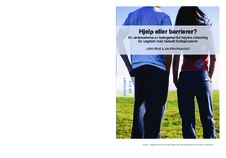| dc.description.abstract | In this report, we present the main findings from the project, “Assistance or barriers? – The use of education as vocational rehabilitation for young people with disabilities”. Chapter 1 gives a summary of the status of knowledge regarding young people with disabilities and their transition into the labor marked. We also present an overview of the most important measures initiated by the government to increase labor marked participation for this group. In January 2004, the rules regulating who were entitled to economic support for educational purposes within a rehabilitation program changed. In chapter 2, we look into the effects of these changes. We use data covering everyone in a certain age group who were granted education as vocational rehabilitation in the years between 2002 and 2005. The analysis indicates that the changes may have resulted in both fewer young people receiving economic support for education as vocational rehabilitation, and fewer young people with disabilities entering the labor force. Chapter 3 addresses a particular group, namely young people (25-35 years) with physical disabilities, mainly defined as cerebral palsy and spina bifida. Two of the topics discussed are: The educational situation for youth with physical disabilities compared to a randomly selected population in the same age group. To what extent is the length of education for young people with physical disabilities important for their situation in the labor marked? As much as 64 percent of the sample with physical disabilities have primary school as their highest level of education, compared with 17 percent in a randomly selected youth population. The level of employment for the group with a physical disability was 38 percent, compared with 86 percent for the randomly selected group. There is a clear indication that an increase in the level of education may have a particularly positive effect for young people with physical disabilities in relation to labor marked participation. In Chapter 4, the topic is of how social workers in NAV administer the regulations that govern access to education as rehabilitation. We start with a brief review of the rule changes in rehabilitation support that was introduced from January 2004. The chapter is based on qualitative interviews with 30 caseworkers in NAV (The Norwegian Labor and Welfare Administration). There is a political ambition that in general young people (under 26 years) shall finance their own education through loans and grants provided by the Norwegian State Educational Loan Fund. This is also true for young people with disabilities, when they do not have so significant impairments that they fall within the exemption criteria. Many of the informants share this point of view. They find it unreasonable and unfair to other young people if young people with disabilities receive economic support to pay for their educational expenses. They should not have any “special advantages" even if they are disabled. Chapter 5 addresses the issues of judgment and discrimination, and discusses what discretion is and how the caseworkers in NAV practice it. Among other things, it is discussed how the use of discretion can be affected by factors “outside the formal rules and regulations”. In chapter 6, the perspective moves a notch up. Instead of questioning the issue if all young people with disabilities get the same or an equivalent treatment in the NAV system, we look at the situation for disabled young people compared to the situation for other young people. Using the ideas of justice developed by Amartya Sen, in particular the capability approach, we ask if is fair that young people with disabilities as a rule should finance their education themselves? One of the reasons for asking this question is that young people with disabilities cannot expect to achieve the same life-cycle income as others. | en |
